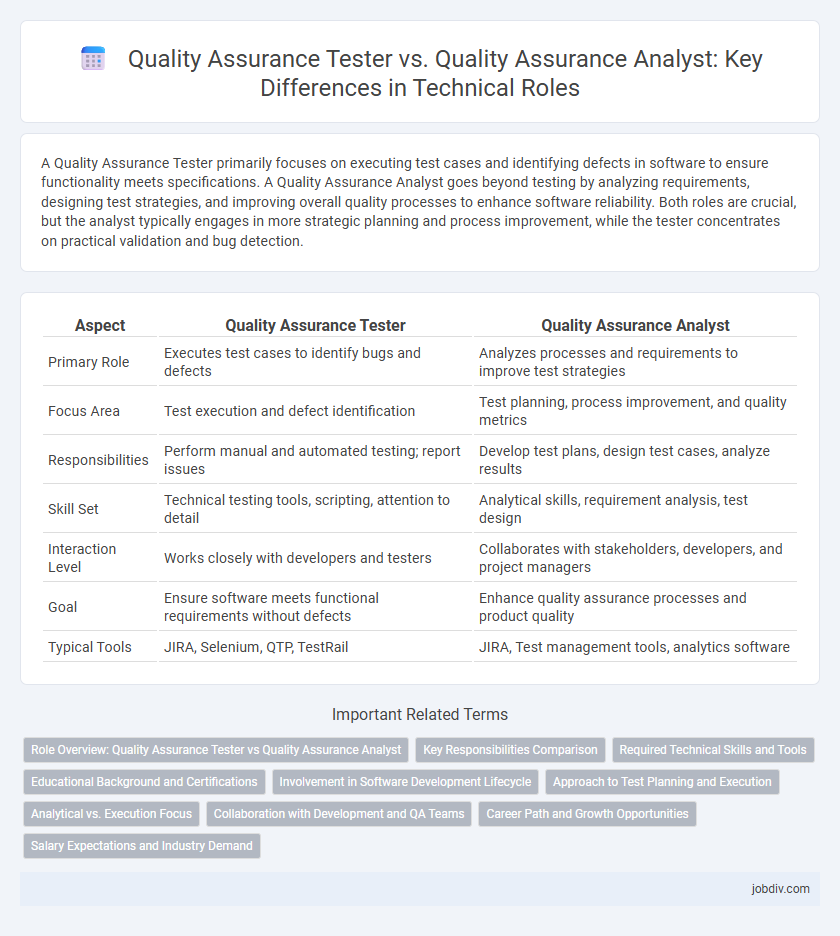A Quality Assurance Tester primarily focuses on executing test cases and identifying defects in software to ensure functionality meets specifications. A Quality Assurance Analyst goes beyond testing by analyzing requirements, designing test strategies, and improving overall quality processes to enhance software reliability. Both roles are crucial, but the analyst typically engages in more strategic planning and process improvement, while the tester concentrates on practical validation and bug detection.
Table of Comparison
| Aspect | Quality Assurance Tester | Quality Assurance Analyst |
|---|---|---|
| Primary Role | Executes test cases to identify bugs and defects | Analyzes processes and requirements to improve test strategies |
| Focus Area | Test execution and defect identification | Test planning, process improvement, and quality metrics |
| Responsibilities | Perform manual and automated testing; report issues | Develop test plans, design test cases, analyze results |
| Skill Set | Technical testing tools, scripting, attention to detail | Analytical skills, requirement analysis, test design |
| Interaction Level | Works closely with developers and testers | Collaborates with stakeholders, developers, and project managers |
| Goal | Ensure software meets functional requirements without defects | Enhance quality assurance processes and product quality |
| Typical Tools | JIRA, Selenium, QTP, TestRail | JIRA, Test management tools, analytics software |
Role Overview: Quality Assurance Tester vs Quality Assurance Analyst
Quality Assurance Testers primarily execute test cases, identify software defects, and ensure products meet specified requirements through manual and automated testing techniques. Quality Assurance Analysts investigate root causes of issues, analyze testing processes for improvements, and align quality standards with business objectives through data-driven insights. Both roles collaborate closely to maintain software integrity, but Analysts focus more on strategic planning and process optimization while Testers concentrate on hands-on defect identification and validation.
Key Responsibilities Comparison
Quality Assurance Testers primarily focus on executing test cases, identifying defects, and reporting bugs to ensure software functionality meets specified requirements. Quality Assurance Analysts concentrate on analyzing product requirements, designing test strategies, and validating process improvements to enhance overall software quality. Both roles collaborate closely to maintain high standards, with Testers emphasizing hands-on testing and Analysts driving strategic quality initiatives.
Required Technical Skills and Tools
Quality Assurance Testers typically require proficiency in manual testing techniques, defect tracking tools like JIRA, and scripting languages such as Python or Java for test automation. Quality Assurance Analysts focus more on test planning, requirements analysis, and familiarity with test management tools like Quality Center or TestRail, along with strong SQL skills for database validation. Both roles benefit from knowledge of continuous integration tools like Jenkins and experience with performance testing tools such as LoadRunner or JMeter.
Educational Background and Certifications
Quality Assurance Testers often hold degrees in computer science or information technology and may obtain certifications such as ISTQB Foundation Level or Certified Tester to validate hands-on testing skills. Quality Assurance Analysts typically possess a background in software engineering, business analysis, or related fields, complemented by advanced certifications like ISTQB Advanced Level or Six Sigma to emphasize analytical and process improvement expertise. Both roles benefit from continuous education in quality management and software development methodologies to ensure comprehensive understanding and application of quality assurance principles.
Involvement in Software Development Lifecycle
Quality Assurance Testers primarily focus on executing test cases and identifying defects during the software development lifecycle, ensuring the product meets functional requirements. Quality Assurance Analysts engage more deeply by analyzing business needs, designing test strategies, and collaborating with developers early to enhance quality throughout development phases. Both roles are integral to maintaining software reliability, but Analysts often influence process improvements and risk assessments beyond hands-on testing.
Approach to Test Planning and Execution
Quality Assurance Testers focus on executing predefined test cases to identify bugs and validate functionality, relying heavily on detailed test scripts and direct interaction with the software. Quality Assurance Analysts emphasize a strategic approach by designing comprehensive test plans that align with business requirements, integrating risk assessment and prioritization into test execution frameworks. Both roles collaborate to ensure test coverage, but Analysts drive the analytical process for continuous improvement while Testers concentrate on hands-on validation and defect reporting.
Analytical vs. Execution Focus
Quality Assurance Testers primarily emphasize execution, meticulously following test cases and documenting defects to ensure software functionality aligns with specifications. Quality Assurance Analysts concentrate on analytical tasks, designing comprehensive test plans, identifying potential risks, and improving testing processes for enhanced product quality. The distinction lies in the tester's operational focus on test execution versus the analyst's strategic approach to quality assessment and process optimization.
Collaboration with Development and QA Teams
Quality Assurance Testers collaborate closely with development teams by executing predefined test cases and reporting defects to ensure functionality aligns with specifications. Quality Assurance Analysts work alongside both QA and development teams to design test strategies, analyze requirements, and improve testing processes based on iterative feedback. Their combined efforts enhance communication, streamline debugging, and accelerate product release cycles through integrated collaboration.
Career Path and Growth Opportunities
Quality Assurance Testers typically begin their careers executing test cases and identifying software defects, gaining foundational experience in testing methodologies and tools. Progression to a Quality Assurance Analyst involves deeper involvement in test planning, requirements analysis, and process improvement, offering enhanced strategic responsibilities and a path toward roles in test management or product quality leadership. Career growth opportunities expand with proficiency in automation, performance testing, and quality metrics analysis, positioning professionals for senior QA roles or transitions into software development lifecycle consulting.
Salary Expectations and Industry Demand
Quality Assurance Analysts typically command higher salary expectations than Quality Assurance Testers due to their broader role in designing test strategies and analyzing system requirements. Industry demand shows a stronger growth trajectory for QA Analysts as organizations emphasize end-to-end quality processes and risk management. Market data from sources like Glassdoor indicates QA Testers average salaries around $55,000-$70,000 annually, while QA Analysts range from $65,000 to $85,000, reflecting their advanced responsibilities.
Quality Assurance Tester vs Quality Assurance Analyst Infographic

 jobdiv.com
jobdiv.com